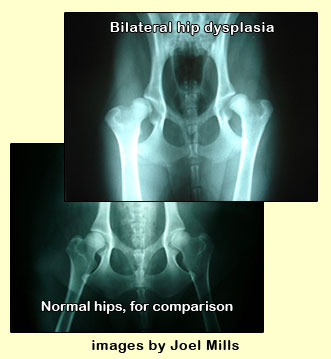What is happening?
-Loosely fitting hip joints cause stretching of the joint capsule and abnormal cartilage wear
-Inflammation and pain result from the altered joint mechanics and cartilage destruction
-Arthritis and reformation of the hip bones progress over time
Clinical signs you might notice in your pet
-Stiffness of the hind legs upon rising, particularly after long periods of rest
-Reluctance to climb stairs or jump
-Tiring easily with play
-Resting more than other dogs of similar age and breed
-"Clunking" noise when walking
-"Bunny hopping" to gain speed when trotting or running
Diagnosis
-Careful orthopedic examination to determine which joint(s) are affected
-Sedated examination to determine the degree of hip looseness and severity of cartilage damage (degenerative joint disease/arthritis)
-Precisely positioned x-rays are taken to document the degree of hip looseness and severity of bone reformation related to cartilage wear
Surgical treatment
-Depending on patient age and diagnostic findings, recommended surgical options may include:
-Rearrangement of the angle at which the components of the hip meet (triple pelvic osteotomy/TPO)-most commonly used for young dogs without significant cartilage wear (arthritis) or bony reformation
-Replacement of the components of the hip (total hip replacement)-most commonly used for older dogs or those with significant arthritis or bony reformation
-Alteration of the hip joint to prevent painful bone contact (femoral head and neck ostectomy/FHO)-most commonly used for smaller dogs
Special postoperative care
-If a triple pelvic osteotomy or total hip replacement was performed:
-Patient activity is strictly limited until adequate healing occurs, usually 6-12 weeks
-X-rays will be taken at specific intervals to evaluate healing at the surgery site
-If femoral head and neck ostectomy was performed, physical therapy will be initiated within several days of surgery, and is usually continued 4-8 weeks
Expected results after surgery
-If a triple pelvic osteotomy was performed, pain is generally relieved, limb use becomes more normal, and the patient does not develop significant hip arthritis
-If a total hip replacement was performed, pain is relieved, limb use becomes more normal, and arthritis is permanently relieved
-If a femoral head and neck ostectomy was performed, a mild limp will likely remain, but pain and arthritis are relieved

What does the grading all mean and the equilivant in different countries?
| OFA (USA) |
FCI (European) | BVA (UK/ Australia) |
SV (Germany) |
| E (Excellent) |
A-1 |
0-4 (no > 3/hip) |
Normal |
| G (Good) |
A-2 |
5-10 (no > 6/hip) |
Normal |
| F (Fair) |
B-1 | 11-18 |
Normal |
| B (Borderline) |
B-2 |
19-25 |
Fast Normal |
| M (Mild) | C |
26-35 |
Noch Zugelassen |
| Mod (Moderate) | D |
36-50 |
Mittlere |
| S (Severe) |
E |
51-106 |
Schwere |
